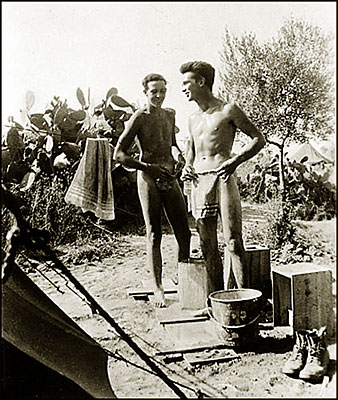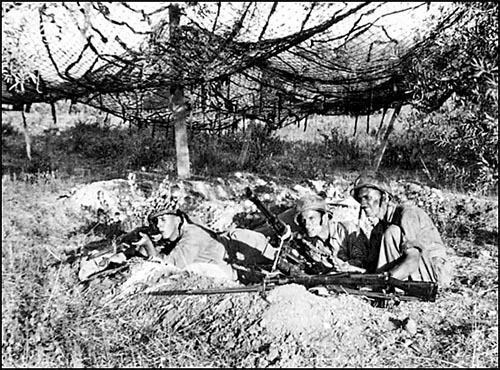|
1943 |
|
7-26 Jul 43 |
"Q" Strip, Tunisia. New IFF sets
installed in our aircraft; a bit late, I'd say. Several 64th aircraft and
crews transferred to 50th Wing as replacements for those lost on D-Day, including
two from the 17th. Bramble remained with #41-7817 and a new crew: Lt. M. E.
Smith (P), F/0 L. C. Grimes (CP), and S/Sgt. J. Kindy, plus one other ship
went to the 50th TCS, 314th Troop Carrier Group. I am assigned to another
crew, flying missions to Sicily in support of Patton's 7th Army. Squadron
ordered to "B" Strip. |
|
|
|
|
7-26/8-25 |
"B"-Strip, El Djem, Tunisia. Bivouacked on
another desert airstrip, 100 miles south of Kairouan. We receive our first Waco
CG-4A gliders, and commence a long period of tow training. Airlifts to Sicily
continue, litter patients evacuated to hospitals in North Africa. 17th
ordered to "J"-Strip. |
|
|
|
|
|
From the time the 17th Troop Carrier Squadron departed Blida, Algeria, during June of 1943, until we arrived in France during September of 1944, ablutions were performed under the most primitive of conditions. Right: Saturday night in the Sahara at "B" Strip, El Djem, Tunisia. Jim Moran and Thad Thomas, July, 1943. (Photo and caption by Jim Moran) |
|
8-25/9-2 |
"J"-Strip, Tunisia. Another bivouac near Kairouan. Combat support missions to Sicily; 17th ordered to Milo, Sicily. |
|
|
|
|
3-4 Sep 43 |
Milo Air Base, (Palermo), Sicily. An excellent
installation. Quartered in a bombed-out church; the first solid roof I have had
over my head since Blida. For exactly one night! Amended orders send the 17th
to Comiso. |
|
|
|
|
4 Sep 43 |
Comiso Air Base, Sicily. Bivouacked in
an olive grove adjacent to the base. The National Insignia undergoes its
third change, when a blue border replaces the red one. [The final change occurred on 1-14-47, when the current version
was adopted, with a red center bar in the rectangles.] |
|
|
|
|
5-7 Sep 43 |
My tent mates and I install a machine gun emplacement, using a 20-mm
gun we stripped from one of the many wrecked ME-109s that litter the field.
This is a former German fighter base, and our mechanics are working to get
some of them in flying condition. 17th airlifts units of the 82nd Airborne
from "M"-Strip, Tunisia, to Comiso in preparation for another drop.
Radio operators are assigned to tower operator duties between flights. Group
carpenters erect a primitive tower of timbers and scrap lumber, with a
tarpaulin roof to shield us from the elements. |
|
|
|
|
|
|
|
|
|
|
|
|
|
8 Sep 43 |
Italy capitulates unconditionally, and airlifts in support of Lt
General Mark Clark's 5th Army escalate. |
|
|
|
|
12 Sep 43 |
Ferried another contingent of paratroopers from
"M"-Strip, Tunisia, to Comiso. Flame suppressors and parapack racks
again installed on ships in preparation for another drop, with five groups
participating. |
|
|
|
|
|
OPERATION AVALANCHE
The dropping of parachute troops behind enemy lines to relieve pressure on the Salerno Beachhead, Italy |
|
|
|
|
14 Sep 43 |
Following two weeks of intensive paradrops, we dropped elements of
the 509th Regimental Combat Team in the hills near Avellino, southeast of
Naples. As on the Sicily mission, several formations of troop carriers were
blown far off course, and dropped their troops miles from the DZ, but the
mission was declared a success in that the beachhead was maintained; our
first toehold on the continent of Europe. |
|
|
|
|
25 Sep 43 |
Carried equipment for the 82nd AB to Sidi-Ahmed, near Bizerte,
Tunisia. |
|
|
|
|
26 Sep 43 |
Airlifted "A" Bags to Cappacio, Italy, for the 504th Parachute
Infantry Regiment; about 15 miles behind the lines. Evacuated litter patients
to Palermo, Sicily; picked up more wounded and flew them to Tunis. |
|
|
|
|
27 Sep 43 |
The mechanics have rebuilt one ME-109, using parts from three others.
Lt. Olin Munnerlyn, one of my favorite pilots, is killed test-hopping the
plane. After flipping a coin with a half-dozen other eager pilots,
"Munn" won (?) . His take-off appeared normal. Then, when he was
about 100 feet off the ground, still over the runway, the Messerschmitt
faltered; recovered; climbed steeply, and then dove straight into the ground
about a mile from the field. He was one of the more popular officers in the
squadron and it was a bitter loss. |
|
|
|
|
|

